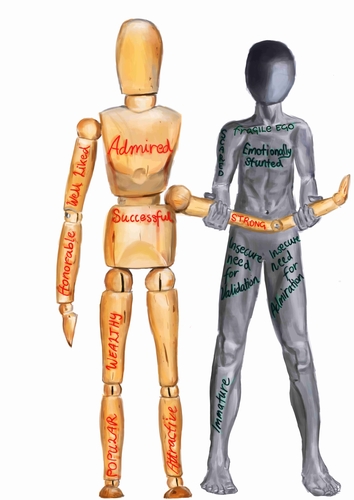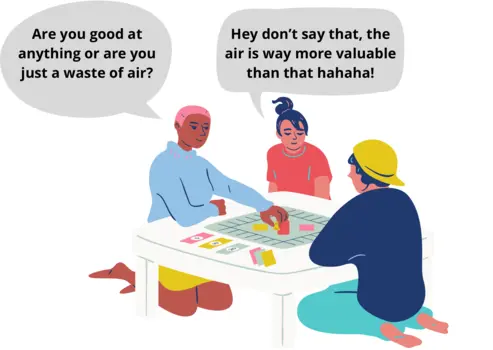When a narcissist experiences a narcissistic injury, they either collapse into the silent treatment or explode into a terrifying rage. In fact, some of the most destructive and intrusive forms of narcissistic abuse are triggered by narcissistic injuries. It’s important to understand what causes narcissistic injuries because it will allow you to predict their behavior so that you can stay out of harm’s way.
A narcissistic injury is caused by a contradiction to a narcissist’s falsified identity. The emotional inadequacies that a narcissist possess make their falsified identity vulnerable to any form of authenticity, like someone calling them out on their lies, causing narcissistic injuries to be a daily occurrence.
These contradictions that cause narcissistic injuries trigger their sense of inadequacy, fear of abandonment and rejection, and their deeply rooted hatred for themselves. These are incredibly powerful negative emotions yet they’re incapable of managing them because of their emotional inadequacies.
The reactions that a narcissist has to narcissistic injuries are a manifestation of their inability to regulate their own emotions. For victims of narcissistic abuse, understanding where a narcissist’s emotional inadequacy comes from can answer a lot of the questions one may have about narcissism and narcissistic abuse so this article is going to guide you through the origin story of a narcissist’s emotional inadequacies.

Why Do Narcissists Experience Narcissistic Injuries?
It’s believed that narcissism originates from an unhealthy or abusive upbringing with unavailable, unresponsive, and inconsistent primary caregivers. When a child is raised under these circumstances they’re unable to develop a realistic sense of self because their unavailable, unresponsive, and inconsistent primary caregivers don’t mirror their thoughts, feelings, emotions, and needs.
Mirroring, also known as parental mirroring, is simply when a primary caregiver reflects or “mirrors” their child’s thoughts, feelings, emotions, and needs back to them. It gives the child the validation, admiration, and reassurance that they need to develop a realistic sense of self.
When a child doesn’t get this much needed validation, admiration, and reassurance from their primary caregivers, they learn to search their external environment for it instead. What this does is it teaches the child to prioritize their external environment, because that is where the validation, admiration, and reassurance is, over their internal environment.
As the child progresses through life and gets more and more validation, admiration, and reassurance from their external environment, they’re led to believe that the reason their primary caregivers didn’t mirror their thoughts, feelings, emotions and needs is because their true identity isn’t good enough. This creates a fear of abandonment, and makes them feel insanely insecure, vulnerable, disposable, unloveable, and inadequate.
Sadly, the emotional inadequacies that a child obtains from the level of neglect that narcissists experienced growing up makes them incapable of regulating their own emotions so instead they compartmentalize all of the negative emotions they have about themselves deep within their psyche and hide them behind a falsified identity that is optimized to accumulate as much narcissistic supply as possible.

This is incredibly dangerous because the negative emotions that are suppressed are extremely powerful, constantly tormenting the narcissist, and constantly looking for ways to escape the psychological box that the narcissist has confined them to.
To sum up everything that has been stated so far, narcissists are vulnerable to narcissistic injuries because they compartmentalize a ton of powerful negative emotions deep within their psyche and guard them with a falsified identity.
Unfortunately, their fragile sense of self makes their falsified identity so frail that the slightest amount of authenticity, like calling them out for their lies or criticizing them, contradicts their falsified identity and triggers their suppressed negative emotions which causes them to experience a narcissistic injury.
Do Narcissists Have Techniques to Protect Themselves From Narcissistic Injuries?
There are a few different ways that a narcissist is able to “manage” these suppressed negative emotions to avoid experiencing a narcissistic injury: projection, scapegoating, and delusion.
Projection is a defense mechanism that everyone uses from time to time where we take traits about ourselves that we find unacceptable and place them on others. Narcissists are heavily dependent on projection because it allows them to take all of their suppressed negative emotions and project them onto other people to avoid contradicting their falsified identity.
Scapegoating is a form of projection. A scapegoat is someone a narcissist will single out to essentially be a repository for all of their suppressed negative emotions. The scapegoat is blamed, ridiculed, mocked, and punished for all of the narcissist’s shortcomings.

Suggested Readings: How Do Narcissists Choose Their Scapegoat, What Causes Scapegoating In Families, What Is Scapegoating In a Family
Narcissists are some of the most delusional people on the planet because they have to be. You see, narcissists desperately need their lies to be true. Meaning that they need their falsified identity that portrays them as charming, charismatic, successful, inspiring, and captivating, to be true. This pushes them to actually believe in their own lies because failing to do so would be a contradiction to their identity and cause a tremendous amount of narcissistic injury.
What Should You Take Away From This Article?
As effective as projection, scapegoating, and delusion are, narcissists still experience narcissistic injuries on a daily basis. If you are dealing with a narcissist in your life, taking the time to learn about narcissistic injuries is going to help you either emotionally or physically escape the narcissistic abuse cycle.
In our article 5 Examples of a Narcissistic Injury you’ll be able to learn a lot more about narcissism and narcissistic injuries as we guide you through 5/9 personality traits of a narcissist outlined by the American Psychiatric Association’s Diagnostic and Statistical Manual of Mental Disorders, Fifth Edition (DSM-5) and explain how they make narcissists vulnerable to narcissistic injuries on a daily basis.
5 Personality Traits of a Narcissist That Make Them Vulnerable to Narcissistic Injuries
- A grandiose sense of self-importance.
- A preoccupation with fantasies of unlimited success, power, brilliance, beauty, or ideal love.
- A belief that he or she is special and unique and can only be understood by, or should associate with, other special or high-status people or institutions.
- A need for excessive admiration.
- A sense of entitlement.
We also highly recommend that you read through our article How Are Narcissists Made to grasp even more valuable knowledge about narcissism and narcissistic injuries.
This will put you in a position from which you can start to dismantle the manipulative structure that narcissistic abuse creates to keep its victims trapped within the narcissistic abuse cycle with the guidance of a qualified professional.
About the Author

Hey, I’m Elijah.
I experienced narcissistic abuse for three years.
I create these articles to help you understand and validate your experiences.
Thank you for reading, and remember, healing is possible even when it feels impossible.
